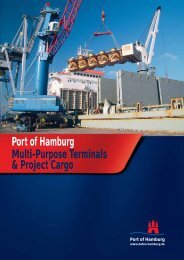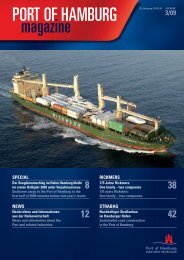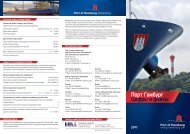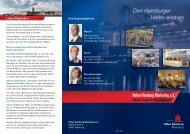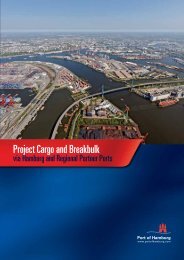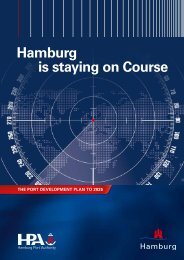Port of Hamburg Magazin 03 - Hafen Hamburg
Port of Hamburg Magazin 03 - Hafen Hamburg
Port of Hamburg Magazin 03 - Hafen Hamburg
- Keine Tags gefunden...
Erfolgreiche ePaper selbst erstellen
Machen Sie aus Ihren PDF Publikationen ein blätterbares Flipbook mit unserer einzigartigen Google optimierten e-Paper Software.
Wir gratulieren dem <strong>Hafen</strong> <strong>Hamburg</strong> Marketing e.V.!<br />
Congratulations to <strong>Port</strong> <strong>of</strong> <strong>Hamburg</strong> Marketing!<br />
Foto: Hasenpusch<br />
Analyzing the handling <strong>of</strong> seaborne cargo one has to<br />
realize that the handling <strong>of</strong> general cargo, which is<br />
in <strong>Hamburg</strong> especially strongly pronounced,<br />
could increase by five per cent in the first halfyear.<br />
In the conventional non-containerized<br />
general cargo 1.2 million tons were handeled in<br />
the first half-year. This comes up to a growth<br />
<strong>of</strong> 2.7 per cent. Since general cargo is handeled<br />
in <strong>Hamburg</strong> by about 97 per cent containerized,<br />
this growth also affects the volume <strong>of</strong> TEU.<br />
Germany’s biggest container port shipped in total<br />
3.7 million TEU (20-feet-standard-containers) in<br />
the first half-year 2010. This comes up to an<br />
increase <strong>of</strong> 4.3 per cent compared to the previous<br />
year. Within the handling <strong>of</strong> containers the shipping<br />
route Asia, which is very important to<br />
<strong>Hamburg</strong> due to its volume and to which belongs<br />
also China as the by far most important<br />
market partner <strong>of</strong> the <strong>Port</strong> <strong>of</strong> <strong>Hamburg</strong>, is again<br />
on a considerable growth curve with a total<br />
number <strong>of</strong> 2.2 million TEU (+6.9 per cent).<br />
Still <strong>Hamburg</strong> is in Europe the leading transshipment<br />
centre with respect to container traffic<br />
with Asia and China. A significant part <strong>of</strong> these<br />
containers is transported as transhipment cargo<br />
via the hub <strong>Hamburg</strong> per feeder ship to the<br />
Baltic Sea region. In contrast to Western feeder<br />
and short sea destinations, that are operated<br />
via <strong>Hamburg</strong> and show already growth rates<br />
between 3.6 und 9.5 per cent for the first six<br />
months <strong>of</strong> the year, the container traffic at the<br />
routes to Scandinavia and the other states <strong>of</strong><br />
the Baltic Sea is still with 9.5 and 3.7 per cent<br />
in the red. Here, also the excellent development<br />
<strong>of</strong> the foreign trade <strong>of</strong> Russia, which increased<br />
in the container traffic with 191,000 TEU via<br />
<strong>Hamburg</strong> by 15.7 per cent in the first half-year,<br />
could not compensate the slumps in container<br />
traffic with the other states <strong>of</strong> the Baltic Sea<br />
caused by the crisis. The handling figures<br />
for the second quarter do already show an<br />
upward tendency for some <strong>of</strong> these Baltic Sea<br />
destinations. Russia still remains unchanged<br />
<strong>Hamburg</strong>s most important trade partner in the<br />
European container traffic and third-strongest<br />
trade partner in the global container traffic<br />
<strong>of</strong> <strong>Hamburg</strong>. >>>




